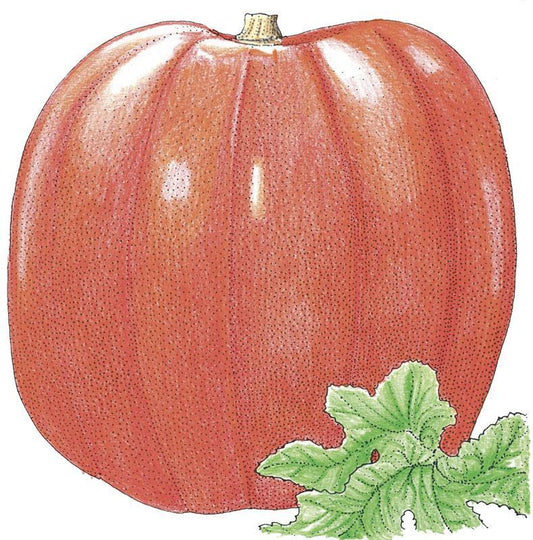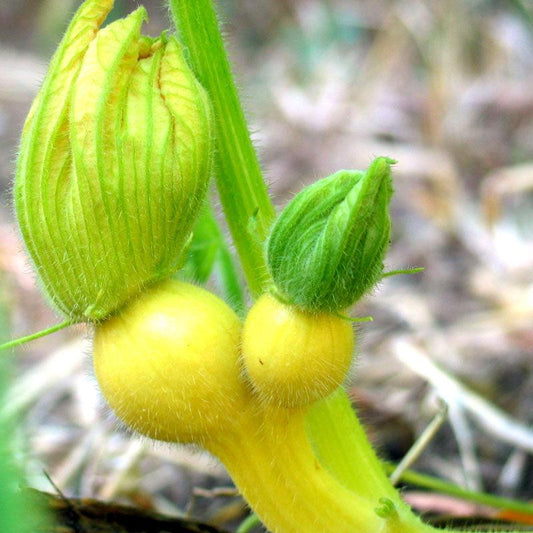Everybody wants to grow pumpkins.
Those beneficent big guys of the vegetable world do take up a lot of garden space, so before you start making hills for the seeds, ponder what you want to do with the pumpkins when fall arrives. Carving at Halloween? Displaying on your front porch in the autumn? Are these for eating? As in pies? Seeds to roast? Slicing wedges to eat raw? What? Raw?
Yes, we have a special pumpkin for that. Keep reading. Tricia shows you how to plant, grow, harvest, cure, and store pumpkins in our video. But to begin at the beginning, what kinds of pumpkins are there, and how do you choose among them?
Grow a Jack-O'-Lantern
Want the archetypal punkin' head? Plant seeds for Howden in your garden and you'll glory in classic pumpkins of about 20 pounds, with long "faces" and sturdy rinds that are easy to carve. They store well too, so if you don't carve them all up you can cook with them later on.
Grow a fairytale pumpkin coach
Set this down in a prominent place inside your house or near your front door, then start thinking that mice might not be so bad if they could be harnessed to draw this around the block. Just like the movies, this picture-perfect pumpkin is called Cinderella. Makes a big statement at 20-40 pounds (and big pies too). This charmer is originally from France, where it's known as Rouge Vif d'Etampes.
Grow tiny pumpkins up a trellis
Jack Be Little pumpkins really are little, at 4" across, and the vines are little too, reaching only five-feet long. So these are tailor-made for growing up a trellis or along a low fence. Either way, kids love picking Jack Be Littles and deciding how to use them -- scoop out the innards and make the Jacks into individual serving dishes, or line them up down the center of the kitchen table. You'll have plenty of time to decide, since these keep for almost a year.
Those raw pumpkins we were talking about
 Musquee de Provence is a stunner, isn't it? "Musquee" describes its musky aroma. Very few seeds and lots of firm, fragrant flesh. The Catherine Deneuve of pumpkins? This photo of Musquee de Provence was snapped by our friend Rob, a garden blogger and innkeeper in the Dordogne region of France. Musquee was sliced in thin wedges and sold as a raw snack at Rob's local street market in Sarlat, France.
Musquee de Provence is a stunner, isn't it? "Musquee" describes its musky aroma. Very few seeds and lots of firm, fragrant flesh. The Catherine Deneuve of pumpkins? This photo of Musquee de Provence was snapped by our friend Rob, a garden blogger and innkeeper in the Dordogne region of France. Musquee was sliced in thin wedges and sold as a raw snack at Rob's local street market in Sarlat, France.
Easiest pumpkin seeds to eat
Roasting pumpkin seeds is a post-Halloween tradition in many families. Now you can roast seeds that are one step easier to eat. Two pumpkins obligingly produce HULL-LESS seeds. The tastiest of the "naked" seeds come from Lady Godiva or Kakai. Both pumpkins sport dramatic stripes too, so use them as decorations before you dig into the seeds.
The best pie pumpkin isn't a pumpkin after all
Many pumpkins make good pies, and we'll tell you about those in a minute, but the classic pie is made with Dickinson, a winter squash. Dickinson is in those cans in the grocery store. Butternut is another winter squash that makes an excellent "pumpkin" pie. Pumpkins to grow for pies are Big Max, Casper, Cinderella, Musquee de Provence, and Small Sugar. Really, Dickinson and Butternut are not such odd choices, since they are of the Cucurbita moschata species, like so many pumpkins. The botanical Latin names are actually quite important in your garden, to keep your pumpkins growing true and not cross-pollinating. No, pumpkins can't read their Latin names, but they do know who's ready to cross-pollinate, and you need to keep those flirtatious kinds of pumpkins apart. Or else.
Pumpkin species

Our chart has marks to show you which pumpkins will cross-pollinate with each other. Don't plant these species in the same season if you want to save seeds and have them "grow true" in the future. Cross-pollination is only a problem if you will be saving the seeds from your garden. ALL pumpkins are in the genus Cucurbita. Within the genus are four species of pumpkins.
Typically, you only have to worry about cross-pollination WITHIN the same species, but there are some exceptions. That's why we made the chart, so you'd have an easy way to check on cross-pollination. Just look up the species name (on the seed pack) of any pumpkins you're wanting to plant together, to see if you might get some accidental crosses out there in the garden patch.
Here are pumpkins by species: Pepo Casper Howden Jack Be Little Kakai Lady Godiva Small Sugar Moschata Musquee de Provence Maxima Big Max Cinderella Argyrosperma.
Hugely important tips for growing giant pumpkins
Do you want to play in the big leagues? The Pumpkin Kings (growers of giant pumpkins) visited our nursery and shared some of their secrets for getting the most out of a pumpkin seed. Grab some Big Max seeds to grow your own 100-pound pumpkin.
White-as-a-ghost pumpkins
If you're loving the white pumpkin look, get spooky with our 10-20 pound Casper (good eating too).

Pick out some seeds from the wide range in our organic pumpkin patch.
Choose from all pumpkins great and small (or white and orange) and grow some next summer in your garden.
Resource Area: Pumpkin Planting & Care Tips
Get the know-how on soil prep, fertilization, and season‑long care:
- Visit from the Giant Pumpkin Kings – Champion grower tips for soil nutrition and vine management.
- August Gardening Checklist: Tips for Your Summer Garden – Advice on watering, pruning, and flower thinning for larger fruit.
- Organic Pumpkin Pie: A Delightful Treat for Every Occasion – See how homegrown pumpkins can be transformed into delicious pies.





